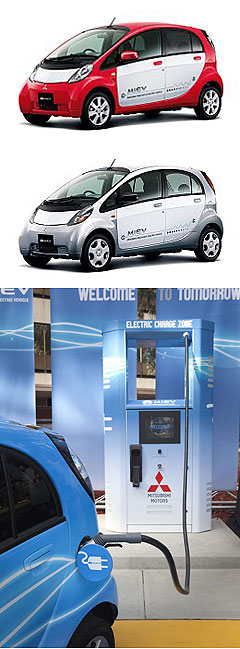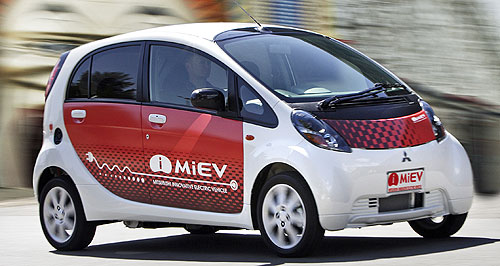Make / Model Search
Future models - Mitsubishi - i-MiEVMitsubishi cuts i-MiEV price – in JapanGo the distance: Mitsubishi will offer two new i-MiEV variants in the Japanese market, each with different-sized driving ranges. Two new Mitsubishi i-MiEVs released in Japan advanced tech could come here11 Jul 2011 TWO new versions of Mitsubishi’s i-MiEV have been released in Japan – including a cheaper entry-level version with a shorter driving range – a month before the pioneering electric vehicle becomes available to the Australian public for $48,800 plus on-road costs. Mitsubishi said both new i-MiEV variants are a direct result of the falling cost of lithium-ion batteries and that, while neither will be launched in Australia, some of their advanced technologies could soon become available here. Now opening Mitsubishi’s expanded EV model range in Japan is the i-MiEV M, which is fitted with a smaller (10.5kW/hour) and lower-voltage (270-volt) battery pack that together with a less powerful 30kW motor delivers 120km of zero-emissions driving. In Japan, the 1070kg i-MiEV M, which produces the same 180Nm of peak torque but only to 1000rpm (rather than 2000rpm in the original i-MiEV), costs 2.6 million yen ($A30,100) before government incentives. Meanwhile, Mitsubishi’s new i-MiEV G flagship weighs 1110kg and incorporates the same 16kWh/330V battery and 47kW/180Nm motor as the standard i-MiEV, but adds an upgraded regenerative braking system that extends the regular model’s driving range from 160km (155km according to a new Australian Design Rule test) to 180km. Also designed to broaden the model’s appeal in Japan, the i-MiEV G – which also adds LED headlights and tail-lights, 15-inch alloy wheels, a leather-clad steering wheel and gearshifter, satellite-navigation and heated front seats – costs 3.8 million yen ($A44,000) before incentives in Japan.  Left: Mitsubishi i-MiEV G (in red) and i-MiEV M (in grey) and a Mitsubishi fast-charge station. Left: Mitsubishi i-MiEV G (in red) and i-MiEV M (in grey) and a Mitsubishi fast-charge station.The i-MiEV M battery can be quick-charged to 80 per cent capacity in just 15 minutes or fully charged in 4.5 hours via a 200V/15amp outlet (or in 14 hours via a 100V/10amp system), while the i-MiEV G battery can be quick-charged in 30 minutes or fully charged in seven hours (200V/15amp) or 21 hours (100V/10amp). While the i-MiEV G’s higher-capacity lithium-ion battery will continue to be produced by Mitsubishi’s joint-venture with GS Yuasa, the M model’s lower-output unit will be supplied by Toshiba. Mitsubishi says the cost of Li-Ion batteries – the most expensive single component within most EVs – has more than halved in the last two years. “Costs have really come down dramatically,” said Mitsubishi Motors Corporation president Osamu Masuko in a news conference last week. “We will try to keep the price down even when the subsidies go away.” Mitsubishi expects both models to attract a further 6000 sales in its current financial year ending next March, while combined global i-MiEV sales – including versions produced for PSA Peugeot Citroen – will total 25,000. Neither model will be part of the 2012 i-MiEV line-up available in Australia from August, but Mitsubishi said the improved regenerative braking function – which recovers energy during braking as well as deceleration – is likely to be incorporated into future i-MiEV models sold here. “We won’t be offering multiple specification levels of the i-MiEV here in Australia because that simply doesn’t make sense for the volumes we’re targeting,” said Mitsubishi Australia head of corporate communications Lenore Fletcher. “We already have the bigger battery. What we don’t have is the regenerative braking feature, which ekes another 20km out of the battery, but it’s something we’re looking at incorporating into future models for Australia.” Other new i-MiEV technologies could also become available in Australia, including the G model’s ‘MiEV remote system’, which enters production in October and allows owners to pre-program battery charging start and finish times, and to pre-activate the vehicle’s climate-control system before entering the car. Mitsubishi already offers Japanese i-MiEV buyers a converter to power laptop computers and other low-draw (100W) electric products, and says it plans to develop and market a more advanced system that can power appliances up to 1500W in its domestic market this financial year. As a result of the power shortages that have followed the nation’s devastating March 11 earthquake and tsunami, however, Japanese car-makers including Mitsubishi, Nissan and Toyota are also investigating technology that allows EVs to discharge power directly into homes. Given the i-MiEV can store enough electricity to power an average household for a day, this would allow houses equipped with solar panels to charge their EVs during the day with ‘clean’ energy, then use the power stored in their car’s battery to supply the household at peak times. Mr Masuko said that, rather than calling into question the future of EVs at a time of increased debate over nuclear power, renewable energy and multiple power sources, the Japanese quake had revealed an unexpected use for EVs like the i-MiEV. “At first we wondered whether EVs could be useful in the disaster zones, and it turned out that they were because gasoline was scarce at the beginning,” he said, adding that Mitsubishi has loaned 89 i-MiEVs to local authorities as part of the relief effort. “Once enough gasoline became available we asked whether we could have them back, but we were told they were still useful so not one has been returned yet.” As GoAuto has reported, while Mitsubishi Australia says the standard i-MiEV’s real-world city driving range is closer to 100km, that is expected to double to about 200km by 2015 as advances in battery technology see weight and efficiency improve. However, given recent research that shows 80 per cent of Australians drive less than 80km per day, even the cheapest i-MiEV M would – in theory – provide adequate transport for at least four in five Australians. While the cost of charging the i-MiEV’s batteries depends on the electricity tariff paid by the consumer, even at an expensive 25-cent/kWh ‘green electricity’ rate Mitsubishi claims the i-MiEV costs just $4 to ‘fill up’. Australia’s i-MiEV – including its battery – will come with the same five-year warranty as the rest of Mitsubishi’s vehicle range, and the company says the battery should retain 80 per cent efficiency even after 10 years. Recharging from ‘empty’ is said to take about seven hours on a 240-volt system – less via fast-chargers planned for some locations around Australia – but each owner will need to have a special 15-amp charging point installed in their garage or workplace, which Mitsubishi says costs about $150. The rear-wheel drive i-MiEV has a top speed of 130km/h and other upgrades for the MY12 version due on sale next month include electronic stability control, side curtain airbags and a new-look front end. Mitsubishi admits the i-MiEV will not be profitable for the company in Australia, but says it will pave the way for eight full-electric (EV) or plug-in hybrid (PHEV) models in its pipeline, with an all-new Outlander PHEV and an all-electric version of the smaller ASX expected on sale in Australia by 2013. Mitsubishi became the first mainstream car-maker to offer a mass-production EV and has so far sold about 10,000 i-MiEVs globally since mid-2009, as well as a further 4000 for PSA. Nissan, which hopes to dominate the EV sector with its larger five-seat Leaf hatchback and a range of models from industrial ally Renault – whose mid-size Fluence ZE sedan is also due on sale in Australia in 2012 – has sold about 8500 Leafs worldwide since December 2010.  Read moreAll future models Alfa Romeo Alfa Romeo Abarth Abarth Alpine Alpine Alpina Alpina Audi Audi Aston Martin Aston Martin BMW BMW Bentley Bentley Chery Chery Brabham Brabham Chrysler Chrysler Chevrolet Chevrolet Cupra Cupra Citroen Citroen DS DS Dodge Dodge Fiat Fiat Ferrari Ferrari Foton Foton Ford Ford Great Wall Great Wall FPV FPV Haval Haval GWM GWM Honda Honda Holden Holden Hummer Hummer HSV HSV Infiniti Infiniti Hyundai Hyundai Jaguar Jaguar Isuzu Isuzu Kia Kia Jeep Jeep Land Rover Land Rover Lamborghini Lamborghini Lexus Lexus LDV LDV Mahindra Mahindra Lotus Lotus Mazda Mazda Maserati Maserati Mercedes-AMG Mercedes-AMG McLaren McLaren MG MG Mercedes-Benz Mercedes-Benz Mitsubishi Mitsubishi Mini Mini Opel Opel Nissan Nissan Peugeot Peugeot Pagani Pagani Proton Proton Porsche Porsche Renault Renault Ram Ram Rover Rover Rolls-Royce Rolls-Royce Skoda Skoda Saab Saab SsangYong SsangYong Smart Smart Suzuki Suzuki Subaru Subaru Toyota Toyota Tesla Tesla Volvo VolvoMotor industry news |
Click to shareMitsubishi modelsResearch Mitsubishi All future models Alfa Romeo Alfa Romeo Abarth Abarth Alpine Alpine Alpina Alpina Audi Audi Aston Martin Aston Martin BMW BMW Bentley Bentley Chery Chery Brabham Brabham Chrysler Chrysler Chevrolet Chevrolet Cupra Cupra Citroen Citroen DS DS Dodge Dodge Fiat Fiat Ferrari Ferrari Foton Foton Ford Ford Great Wall Great Wall FPV FPV Haval Haval GWM GWM Honda Honda Holden Holden Hummer Hummer HSV HSV Infiniti Infiniti Hyundai Hyundai Jaguar Jaguar Isuzu Isuzu Kia Kia Jeep Jeep Land Rover Land Rover Lamborghini Lamborghini Lexus Lexus LDV LDV Mahindra Mahindra Lotus Lotus Mazda Mazda Maserati Maserati Mercedes-AMG Mercedes-AMG McLaren McLaren MG MG Mercedes-Benz Mercedes-Benz Mitsubishi Mitsubishi Mini Mini Opel Opel Nissan Nissan Peugeot Peugeot Pagani Pagani Proton Proton Porsche Porsche Renault Renault Ram Ram Rover Rover Rolls-Royce Rolls-Royce Skoda Skoda Saab Saab SsangYong SsangYong Smart Smart Suzuki Suzuki Subaru Subaru Toyota Toyota Tesla Tesla Volvo VolvoMotor industry news |










Facebook Twitter Instagram